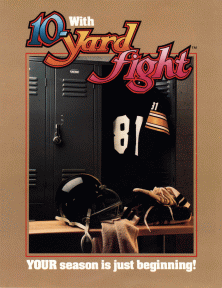10-Yard Fight
| 10-Yard Fight | |
|---|---|
 North American arcade flyer. | |
| Developer(s) |
|
| Publisher(s) | |
| Platform(s) |
Arcade
|
| Release | |
| Genre(s) | Sports |
| Mode(s) | Single-player, multiplayer |
| Cabinet | Upright |
| Arcade system | Irem M-52 hardware |
| CPU | Z80 @ 4 MHz |
| Sound |
Click to expand
|
| Display |
Click to expand
|
10-Yard Fight (10ヤードファイト Ten Yādo Faito) is a 1983 American football arcade game that was developed and published in Japan by Irem and published in the United States by Taito and in Europe by Electrocoin.
Gameplay

10-Yard Fight is viewed in a top-down perspective and is vertical scrolling. The player does not select plays for either offense or defense. On offense, the player simply receives the ball upon the snap and either attempts to run with the quarterback, toss the ball to a running back, or throw the ball to the one long distance receiver – basically the option offense. On defense, the player chooses one of two players to control, and the computer manipulates the others. The ball can also be punted or a field goal can be attempted.
The game has five levels of difficulty; from easiest to most difficult: high school, college, professional, playoff, and Super Bowl. If the player wins both halves of an "accelerated real time" 30-minute half at an easier level, the player advanced to the next level of difficulty, like a career mode.
Ports
The arcade game was later ported to the Family Computer by Irem first in Japan, and later published in North America and Europe by Nintendo in 1985 for the Nintendo Entertainment System. The arcade game was also ported to the MSX home computer also by Irem, but exclusively in Japan.
While graphically similar, there were some fundamental differences between the arcade and Famicom/NES versions of the game. The arcade version only sought to simulate the offense, with the team attempting to score a touchdown, which would ultimately lead the player to the next level. The Famicom/NES version was developed to allow both defense and offense, as well as a simultaneous 2-player mode. However, this mode is flawed in that the 2nd (red) player retains the AI cheats, giving them an unfair advantage.
Reception
The Pittsburgh Post-Gazette called it the "patriarch of football games".[1] Sports Illustrated's Adam Duerson stated that while no one remembered it or could say what makes it great, it is worth recognition for the fact that it brought football games out of the Atari era, setting a simple precedent for future football games.[2] UGO Networks' Adam Swiderski called it "downright advanced" compared to earlier football titles. He added that while it looked neat and had a quality soundtrack, it didn't play like "real football".[3] The Columbus Dispatch's Nick Chordas said that it was realistic for the time, commenting that the players looked like real people.[4] N-Sider called it more like a racing game than a football game, due to the objective being racing for a first down to increase players' time.[5] Author Bj Klein, however, called it less realistic than Tecmo Bowl.[6] The Journal News' called it an "immortal classic".[7]
References
- ↑ "Post-Gazette.com". Docs.newsbank.com. 2002-11-19. Retrieved 2012-08-15.
- ↑ "SI.com - Scorecard Daily - Adam Duerson: Madden '06 is best ever - Thursday August 11, 2005 3:03PM". Sportsillustrated.cnn.com. 2005-08-11. Retrieved 2012-08-15.
- ↑ "A Brief History of Football Games". UGO.com. 2007-09-05. Retrieved 2012-08-15.
- ↑ http://www.dispatch.com/live/contentbe/dispatch/2006/08/21/20060821-C3-03.html
- ↑ "10 Yard Fight". N-Sider.com. 1985-08-30. Retrieved 2012-08-15.
- ↑ College Weekend...a Strange, True Story - Bj Klein - Google Boeken. Books.google.com. Retrieved 2012-08-15.
- ↑ "Madden bigger, better than ever". Pqasb.pqarchiver.com. 2009-08-13. Retrieved 2012-08-15.
External links
- 10-Yard Fight at arcade-history
- 10-Yard Fight at Coinop.org